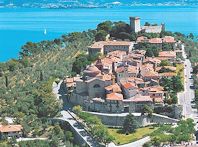 |
Castiglione del Lago
lies on the shores of
Lake
Trasimeno in
Umbria. A trip aound the lake, stopping at
Castiglione del Lago and if possible visiting Isola
Maggiore en route, is a pleasure not to be missed
when visiting this part of Umbria. The main sights are the
Castello del Leone (the Fortress of the Lion) which was built
for the Emperor Frederick II by Elia di
Cortona and finished in 1247. It has square towers on four of the corners and a triangular donjon known as the Mastio on the other. The
Palazzo del Comune was built by Ascanio della Corgna in Renaissance style and is now the civic museum.
More about
Lake Trasimeno.
|
|
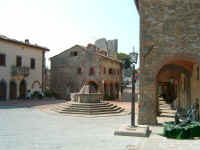 |
Civitella
in Val di Chiana is located on a high ridge between the valley of the Chiani river and the Val d'Ambra, and providing spectacular views of both.
Important sights in Civitella in Val di Chiana include the Chiesa di Santa Maria, the Rocca (Fortress) and the Palazzo Pretorio (Praetorian Palace). The Rocca, which was German headquarters during WW II, was extensively bombed and has not been restored. The Aretine gate suffered a similar fate, but the Siennese gate remains intact.
This tranquil and charming village is well worth a
visit.
More about Civitella
in Val di Chiana.
|
|
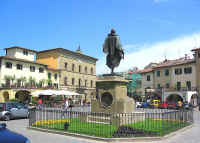 |
Greve in Chianti
is effectively the market town of the Chianti
Classico wine area. Unlike the majority of Chianti towns, Greve is located on
the floor of a valley instead of on a hill top, about half-way along the scenic
Chiantigiana highway (SS 222) that runs from Florence to
Siena. Greve has an attractive, arcaded, triangular piazza
(Piazza
Matteotti)
with several ceramics and wine shops, as well as
restaurants. The hills surrounding Greve boast many beautiful agriturismi and other rural vacation
accommodations, making Greve a centre for farm house holidays in this part of Tuscany. The Greve web site contains much useful information about Chianti.
More about Greve in
Chianti.
|
|
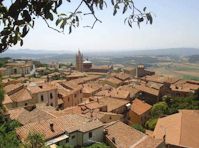 |
Massa Marittima
is still off the beaten track considering the beauty of
its location and the interest of the town itself. Massa
Marittima, despite its name, is in the "metaliferous
hills" region of the Alta
Maremma
and not very near the sea. The town can be divided into three distinct areas, la Citta Vecchia (old city), la Città Nuova (new city) and the Borgo, each area being architecturally distinct.
Massa Marittima possesses a magnificent cathedral
situated in the splendid Piazza Garibaldi. The "Balestro del Girifalco"
crossbow competition takes place twice a year on the first Sunday after May 20 and the 2nd Sunday of August.
More about Massa Marittima.
|
|
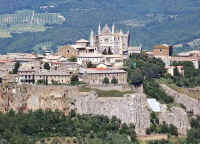 |
Orvieto,
Italy
is situated on the flat summit of a large butte of volcanic tuff, one of the most dramatic townscapes in Europe, rising above the vertical cliffs that are extended by defensive walls of the same stone. The facade of the
Duomo of Orvieto, a masterpiece of Italian gothic art, is equally spectacular, consisting of bands of black and white stone decorated with bronze dragons, gold mosaics and marble bas-reliefs by Lorenzo Maitani. Other sights in and near Orvieto are the deep spiral Well of St. Patrick (Pozzo di San Patrizio) and other caves and tunnels, some dating from Etruscan times.
More about Orvieto.
|
|
|

